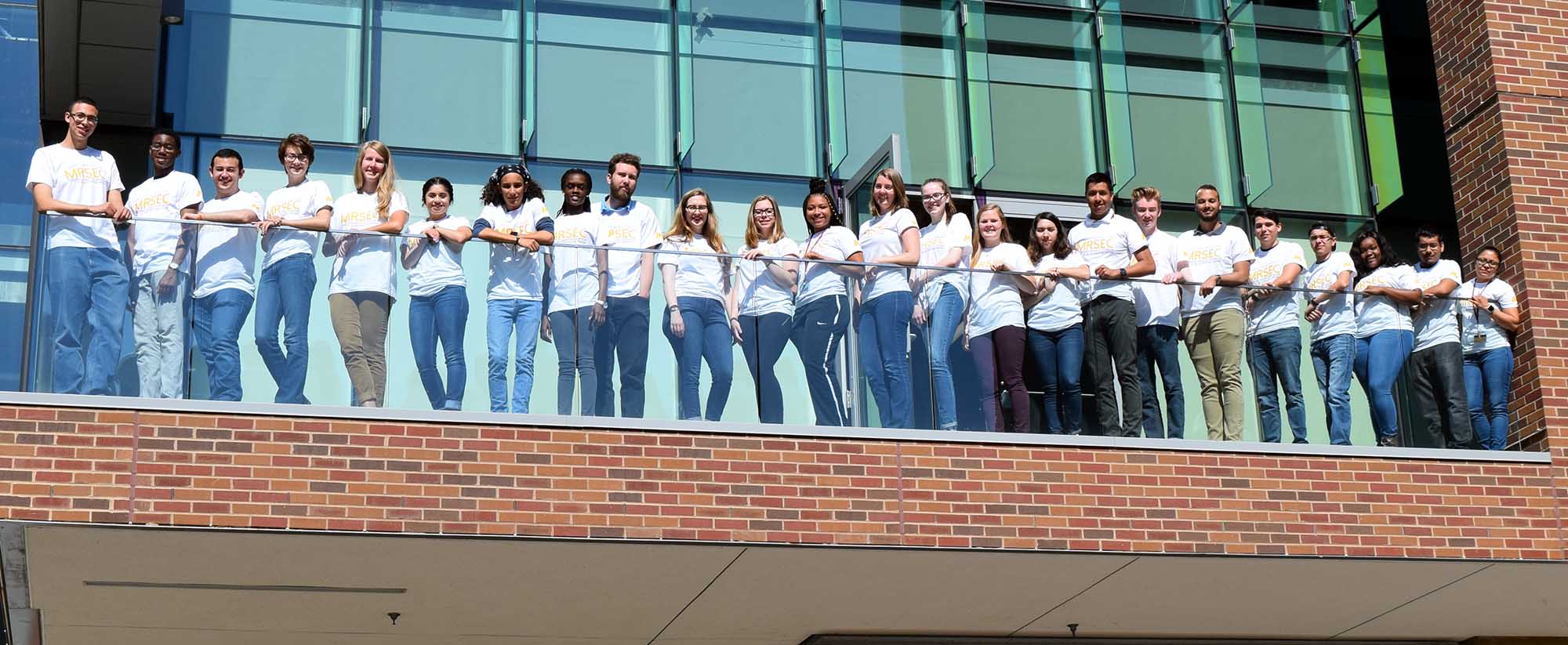
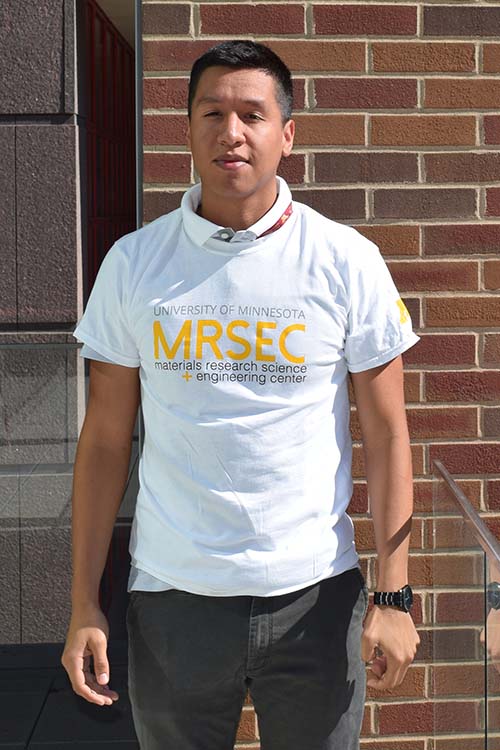
Home Institution: University of Texas Rio Grande Valley
REU Mentor:
Phase Behavior of Salt Doped, Homopolymer-rich A/B/A-B Ternary Blends
Conductive polymeric materials with a robust, high modulus, and high ionic conductivity have been of particular interest as of late due to their potential direct applications in Lithium Ion Batteries (LIB’s). Their potential as a replacement for the separator and the highly flammable liquid electrolyte is an interesting and exciting possibility. It is broadly accepted that a co-continuous structure leads to these interesting properties. Thus, understanding the thermodynamics of mixing and the corresponding phase behavior is an important first step.
A/B/A-B ternary polymer blends which consist of two homopolymers (A and B) and the corresponding diblock copolymer (AB) have been analyzed and studied thoroughly over the last couple of decades. An equilibrium bicontinuous microemulsion (BμE) structure can be obtained when the components are suitably designed. Here, we will explore the addition of a salt (LiTFSI) and its effects on the structure of an A/B/A-B ternary polymer blend of poly(ethylene oxide) (PEO), polystyrene (PS), and poly(ethylene oxide)-block-polystyrene (PS-b-PEO) diblock copolymer. We will first focus on blends with small PS-b-PEO compositions and explore the potential macroscopic phase separation by cloud point measurement. The ion concentration dependence will also be investigated. After that, an experimental phase diagram will be constructed and fit with a thermodynamic model. The result will guide design of ion-containing polymer mixtures with multiple components.
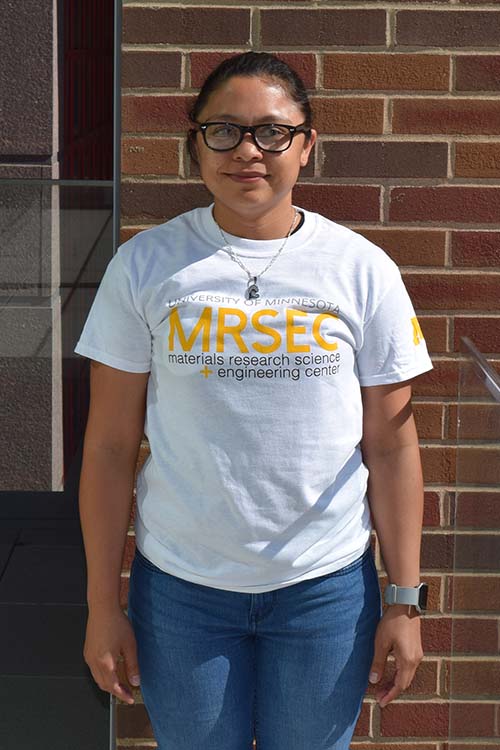
Home Institution: University of Texas Rio Grande Valley
REU Mentor: Cari Dutcher
Extensional Rheology in Polyelectrolytes
Extensional rheology is a powerful technique applied to understand and control the behavior of non-Newtonian fluids encountered in numerous applications such as spraying, printing, potable water production, and food processing. The viscoelastic capillary thinning of fluids is an essential dynamic process used to determine the extensional flow properties of polymeric materials. For complex fluids, capillary thinning can be affected by inertia, viscosity, and other external forces that distort the shape of the macrostructure. Capillary Breakup Extensional Rheometry (CaBER) is an experimental procedure that describes the behavior of complex fluids by applying time-dependent extensional stresses. The elongational break-up of high molecular weight polyelectrolytes was studied here to calculate their extensional relaxation time using constitutive models. The extensional viscosity for these ionic polymers was also analyzed. As the extensional relaxation time of polymer increases, the extensional viscosity also increases. The correlation between both extensional parameters was studied, which can inform commercial applications.

Home Institution: University of Minnesota
REU Mentor:
Patterning Perpendicular Magnetic Tunneling Junctions
In the scope of this project, we focus on an area of spintronics known as perpendicular anisotropic Magnetic Tunnel Junctions (MTJs). Inside MTJs, a basic stack consists of a tunnel barrier and 2 ferromagnetic electrode layers. In a tunneling process, the Tunneling Magneto Resistive (TMR) effect, a quantum mechanical phenomenon, is determined by the tunneling conductance which can change based on the whether the magnetizations of the 2 electrodes are parallel or anti-parallel. Recently, it’s been shown that spin-orbit interactions in magnetic conducting layers can produce strong Spin Transfer Torques (STTs) on a proximal magnetic layer and without disturbing the tunneling barrier (typically MgO). When requiring different anisotropy strengths, TMR curves in relation to PMTJ structures is considered. On a final note, prediction of the spin-Hall effect allows for the generation of substantial amounts of dissipation-less quantum spin current in semiconductors and ferromagnetic materials by (spin) injection. Since spintronic devices aren’t set back by the velocity limit of electric charge (≈1-2*107 cm/s) and have ultra-low power consumption, they are a great candidate for future three-dimensional chips in computation and high-density, non-volatile storage systems such as Spin-Transfer Torque Magnetoresistive Random Access Memory (STT-MRAM).
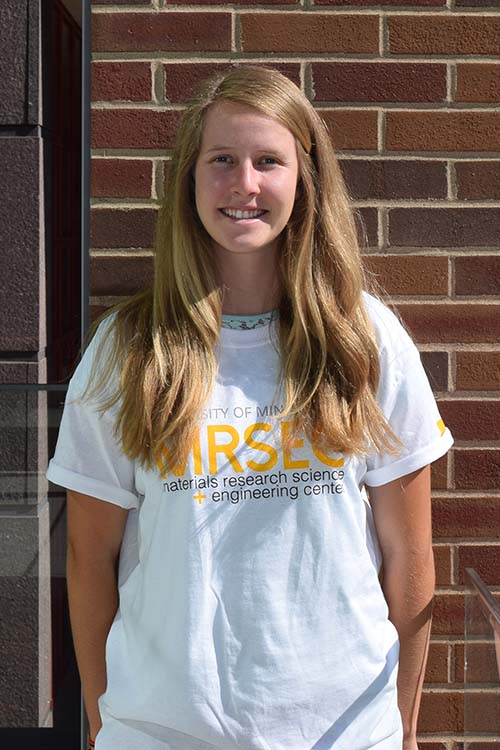
Home Institution: Fort Lewis College
REU Mentor: Sungyon Lee
Particle- Induced Instabilities on a Fluid Interface
Flows of fluids with particles are relevant in both nature and industry. In nature, an example is the transport of sediment by rivers and tides and in industry, the flow of proppant in hydraulic fracturing. These are just a couple of examples in which suspensions of particles in a fluid are encountered. It is well-known that when a less viscous fluid is driven into a more viscous fluid inside a porous media, this causes an instability known as viscous fingering. This instability has been extensively studied. In this work, we are interested in what happens to the fluid-fluid interface with the addition of a suspension of non-colloidal particles within the Hele-Shaw cell. Specifically, we investigate cases in which a layer of suspension beneath a layer of air is drained from the cell. We vary the suspension concentration, gap width, particle size and flow rate to determine each variable’s effect on the observed instability. It has been observed that for thin gaps, slightly larger than the particle diameter, the particles move slower than the bulk fluid flow causing them to accumulate on the interface. This leads to an interfacial instability in which the particles stretch from the interface and create long filaments, due to the viscous drag between the particles and the walls of the cell. From experimental results we see that for the particles to move slower than the bulk fluid the suspension concentration, the gap width of the Hele-Shaw cell and particle diameter all influence this instability.

Home Institution: Arizona State University
REU Mentor: Andre Mkhoyan
Characterization of the Core/Shell Interface and Oxidation of Si/SiN Core/Shell NCs
Semiconductor nanocrystals (NCs) are of wide interest within materials science due to their highly tunable optoelectronic properties, which are different from those of their bulk counterparts. The optical properties of fluorescent NCs can be further improved by coating the NCs with protective shells. We are interested in finding sustainable, non-toxic NCs that could be feasible alternatives to the widely used semiconductor NCs that are made from toxic materials such as CdSe. In this study, we investigated the elemental distribution across the core/shell interface of nonthermal plasma-grown Si/SiN core/shell NCs by fitting computational models of the NCs to scanning transmission electron microscopy – electron energy loss (STEM-EEL) spectrum images. Additionally, we have employed these methods to analyze the physical changes to the NCs upon oxidation. The focused investigation on the structure of Si/SiN NCs will educate future improvement to the synthesis of core/shell NCs, thus optimizing their optoelectronic properties.
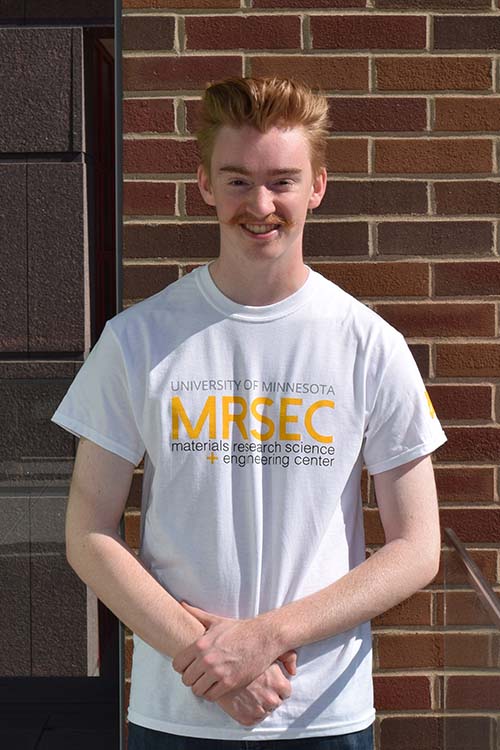
Home Institution: Cornell University
REU Mentor: Martin Greven
X-Ray Scattering and Nonlinear Conductivity Measurements of Strongly Correlated Materials
Scattering and transport measurements represent two paradigms of techniques for probing condensed matter systems by allowing one to deduce their structural and electronic behaviors,
respectively. Used in ensemble, these techniques provide a powerful platform for advanced materials characterization and the investigation of fundamental physical phenomena such as those
found in strongly-correlated materials, where non-negligible electron-electron and exchange interactions manifest in coherent macroscopic behaviors such as ferromagnetism and high-temperature
superconductivity.
LaxSr1-xCoO3 (LSCO) thin films, extensively studied within IRG-1, are a system which undergoes an insulator-to-metal transition accompanied by ferromagnetic ordering when a gate bias is applied.
Here we present work done by in-operando synchrotron x-ray scattering to further characterize the structural changes LSCO undergoes with gating. When compared with previous transport measurements,
this structural information may provide additional insight into the doping mechanisms of LSCO.
Also of interest are high-temperature superconductors, distinguished by their complex phase diagrams where relations between competing forms of ordering are not fully understood. Here we present
work done to apply contact-free nonlinear conductivity - a technique for performing ultra-sensitive measurements of non-trivial phase features - to a wider class of thin film and exfoliated materials.
This technique has the potential to discern between different proposed pairing mechanisms in these materials.

Home Institution: University of Texas Rio Grande Valley
REU Mentor:
Phase purity & chemical composition of La1-xSrxCoO3 nanoparticles synthesized via halide- and nitrite-based molten salts
Perovskite oxides have demonstrated a plethora of fascinating and significant material properties, such as high temperature superconductivity, colossal magnetoresistance, ferroelectricity, and co-incident metal-insulator, structural, and magnetic phase transitions. Perovskite cobaltites doped with alkaline-earth metals, such as La1-xSrxCoO3 (LSCO), have shown a clear form of magneto-electronic phase separation which in bulk systems is heavily influenced by stoichiometry. In addition to chemical composition effects, magneto-electronic phase separation behavior has the potential to also be affected by dimensionality. To study this behavior, nanoparticles (NPs) of La1-xSrxCoO3 (x = 0, 0.05, 0.10, 0.20, 0.30) were recently synthesized through a binary-nitride ionic flux method (a new approach) and previously through a sol-gel with binary-chloride ionic flux synthesis (an older approach). These NPs were studied as a function of composition and particle size to determine the influence of these effects on the stoichiometry and magnetic properties. Currently, x-ray diffraction (XRD) has demonstrated that both methods can make perovskite NPs at low temperatures and low calcination times for all concentrations, but the newer type of NPs contained Si contamination derived from glass instruments and the old type NPs formed SrCO3 at high Sr concentrations. In addition, Scherrer’s equation found an average particle size decrease of 15.42 nm for the new NPs. Furthermore, scanning electron microscopy (SEM) and energy dispersive analysis of x-rays (EDAX) also have hinted to smaller particle sizes with less stoichiometric variations in Sr content for the new NPs compared to the old NPs. Further work will focus on halting the contamination of Si in the new NPs, continuing a detailed structural characterization analysis, and beginning magnetometry measurements of the NPs.
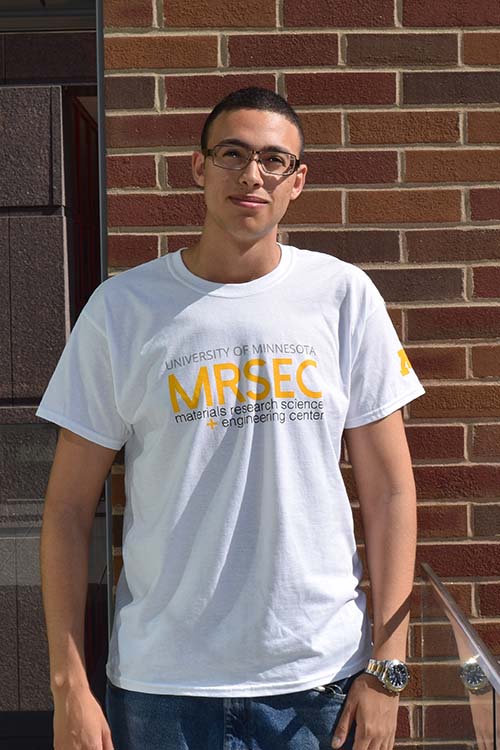
Home Institution: San Francisco State University
REU Mentor: Steven Koester
Rectifier Device Implementation via Wide Band Gap Oxide Semiconductor and Transition Metal Dichalcogenide
The core of the research project is to implement a rectifier (pn-junction) device by utilizing a transition metal dichalcogenide: (p-doped) WS2 in conjunction with a wide-band-gap oxide material:
(n-doped) β-Ga2O3. The reason for using these specific materials involves the fact that β-Ga2O3 is a highly stable semiconductor, and that it is an excellent choice to pair with WS2 due to the band
alignment configuration. The first 2D material to be discovered was Graphene; it was found to exhibit many useful physical properties at the atomic-layer-level. However, the major limiting factor of
Graphene is that it lacks the presence of a band gap. This is precisely why we turn to a class of materials known as TMDs (Transition-Metal-Dichalcogenides). TMDs are a new subclass of 2D materials
that consist of a transition metal sandwiched between 2 atomic layers of a Chalcogen. We are most interested in TMDs at the monolayer because that is when they exhibit a direct band gap. This means
that TMDs can be instrumental in the design and implementation of many optoelectronic and electronic devices. Firstly, I will utilize a technique known as mechanical exfoliation to thin these
materials to the monolayer-level, so I can employ this feature. Secondly, Raman spectroscopy will be utilized in conjunction with optical microscopy to perform characterizations, and to measure
sample thicknesses on a finalized substrate. Finally, electrodes will be connected to the device and efficiency testing will take place. We anticipate that our distinctive choice of materials will
result in a highly efficient rectifier(pn-junction) device.
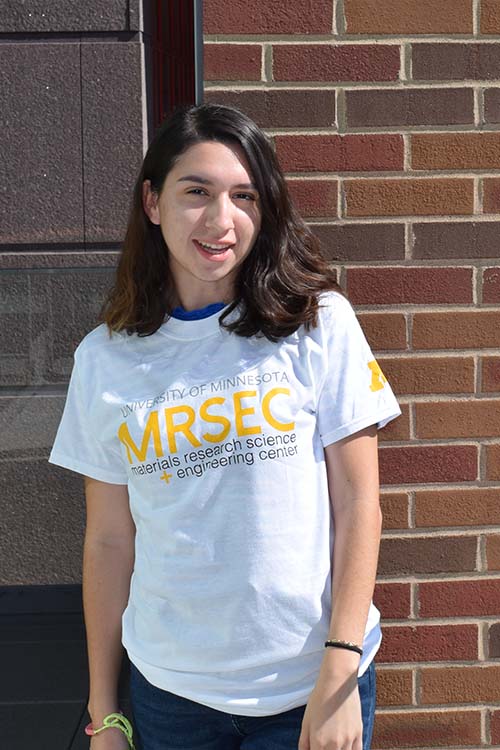
Home Institution: University of Texas Rio Grande Valley
REU Mentor: C. Daniel Frisbie
Influence of substrates on the conductivity of rubrene single crystals
Organic field effect transistors (OFETs) based on organic semiconductors (OSCs) have rapidly surged given the flexibility, low cost, lightweight and environmental friendly characteristics.
Among OSCs, rubrene single crystals provide an ideal platform for charge transport study due to the demonstrated high mobility in OFETs and the resulting benchmark performance.
Preliminary research has concluded that the conductivity of rubrene crystals greatly depends on the substrate utilized. For example, the conductivity of rubrene crystals on silicon dioxide (SiO2)
can be 3-4 orders of magnitude higher than the conductivity of free-standing rubrene crystals. This research will focus on the alteration of the substrate to study the direct influence of
substrate on the conductivity of the device. A comparison will be made between free-standing crystals and crystals on SiO2, Al2O3, and polymer substrates. The devices will be fabricated on
Si/SiO2 wafers by conventional lithography technique, and the rubrene crystals will be placed between two gold electrodes and serve as conductors for the current-voltage measurements.
Other techniques, including atomic layer deposition and spin-coating, will be used to fabricate the Al2O3 and polymer substrates. This experiment will provide valuable information on
the possible mechanism of interfacial doping of organic semiconductors.
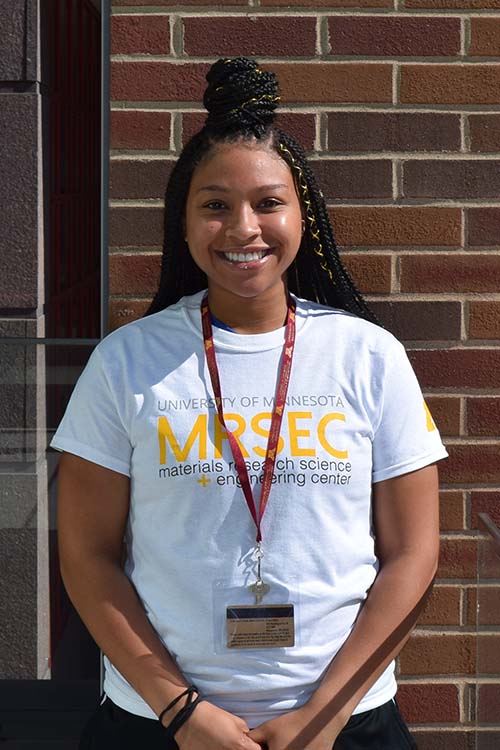
Home Institution: Dillard University
REU Mentor: Uwe Kortshagen
Characterization of Germanium Tin Alloy Nanocrystals produced using Nonthermal Plasma Synthesis
Incorporating the element Tin (Sn) into the element Germanium (Ge) to fabricate Germanium Tin Alloy Nanocrystals has been increasing in interest due to its useful properties. Semiconductors have a band gap characteristic of their material which we can tune through quantum confinement, alloying, doping, etc. We are trying to use the tin concentration as a tool to vary the strain in the germanium crystal and as a result, controllably change the band gap energy. A nonthermal plasma synthesis reactor will be used to fabricate crystalline germanium nanoparticles with varying concentrations of tin. Using Raman spectroscopy, I will view the vibrational modes within the Nanocrystals to see the chemical bond characteristics within the nanocrystals. Through X-ray diffraction, the strain within the Ge nanocrystal can be determined along with the maximum achievable tin content. We hypothesize that using a nonthermal plasma to synthesize these alloys may allow for enhanced tin incorporation above those achievable in thermodynamic equilibrium.
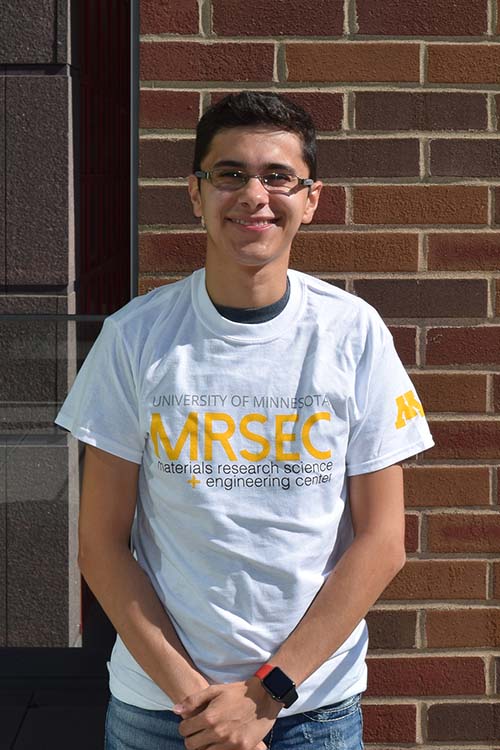
Home Institution: University of Texas Rio Grande Valley
REU Mentor: Uwe Kortshagen
Photoluminescence of Silicon Quantum dots with Silicon Nitride Shell from Nonthermal Plasma
Quantum dot (QD) semiconducting materials have developed strong interest due to their nanoscale properties. Their wavelength of emission can be tuned depending on the size of the quantum dot.
Because of these unique properties, QDs have been used for photoluminescence (PL) applications such as TVs and LED lighting. Silicon QDs with a silicon nitride (SiNx) shell will be developed
using a nonthermal plasma reactor and their emission wavelength during an oxidation process will be studied using Time-Resolved PL. We expect the SiNx shell to provide an air-stable
and environment friendly state during oxidation. The thickness and synthesis constraints of the SiNx shell will be studied to determine their effect on emission Lifetime and Quantum Yield.
This will help us determine which quantum dots will have the performance for different applications.
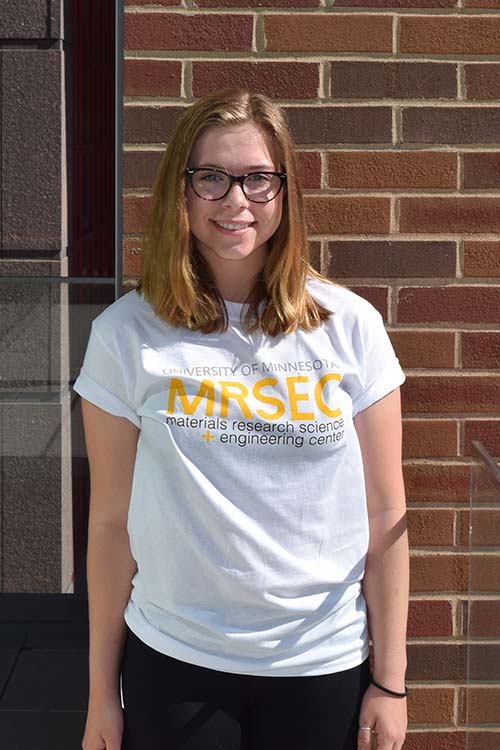
Home Institution: College of Saint Benedict and Saint John's University
REU Mentor: Xioajia Wang
Designing 3D printed holders to measure magnetic anisotropy within thin-film samples
Magnetic anisotropy can be simply defined as the preference for magnetization to lie in a particular direction within a sample. This property is important when looking at magnetic thin films –
the anisotropy in a film can influence other important properties, such as thermal stability and the ease of switching the magnetization direction. This is seen when comparing a film with
perpendicular anisotropy (PMA) versus a film with in-plane anisotropy, with PMA normally being preferred due to the better expression of the properties mentioned above. When looking at
Iron Palladium (FePd) alloy films, it is believed that they may exhibit cubic anisotropy as well as the more common uniaxial anisotropies. If this is the case and cubic anisotropy has
similar benefits to PMA, it could affect how we view and make this thin film technology. To test this theory, a small sample must be suspended in a magnetic field at exactly 45 degrees
from vertical. To do this, a holder made of 3D printed plastic is needed to load the sample in the correct position, while not interfering with the magnetic field. This holder has been created,
and with it we will be able to more easily and accurately test for cubic anisotropy within the film of FePd.
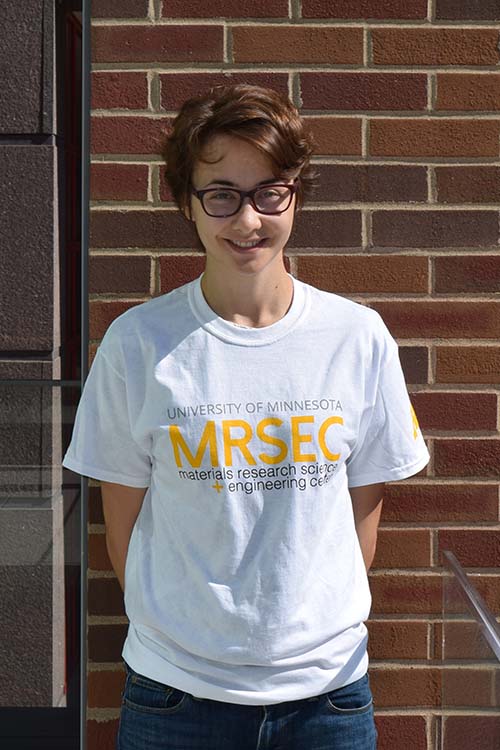
Home Institution: The Pennsylvania State University
REU Mentor: Samira Azarin
Functionalized Graphene Oxide for Targeting Ovarian Cancer Spheroids
As the deadliest gynecological cancer, ovarian cancer presents a pressing women’s health issue, and only in the past decade have multicellular aggregates (spheroids) been widely recognized as
metastatic. Spheroids are not only capable of intra-abdominal dissemination, but also tend to resist drug and radiation therapies, and, therefore, pose a significant challenge when designing
effective treatments. Accordingly, we aim to develop a selective, non-invasive method of addressing spheroids when treating ovarian cancer by using hyaluronan-functionalized, PEGylated graphene
oxide (HA-PEG-GO). We have shown that PEGylation of graphene oxide increases overall biocompatibility and stability in the biological milieu without adversely affecting its ability to inhibit
adhesion of spheroids to extracellular matrix proteins. However, PEG-GO interacts with cancer cells and healthy cells indiscriminately.
In future work, we intend to further functionalize PEG-GO with hyaluronan and exploit CD44, a hyaluronan-binding surface protein that is overexpressed in cancerous cells, to induce preferential association of HA-PEG-GO with spheroids. This novel selectivity would reduce harm to healthy cells and indicate HA-PEG-GO’s superiority as a therapeutic delivery system. Furthermore, we plan to investigate methods of inducing cancer cell death (e.g. photodynamic therapy) using HA-PEG-GO, though demonstrating that HA-PEG-GO could preferentially bind to spheroids to prevent dissemination would be significant in and of itself.
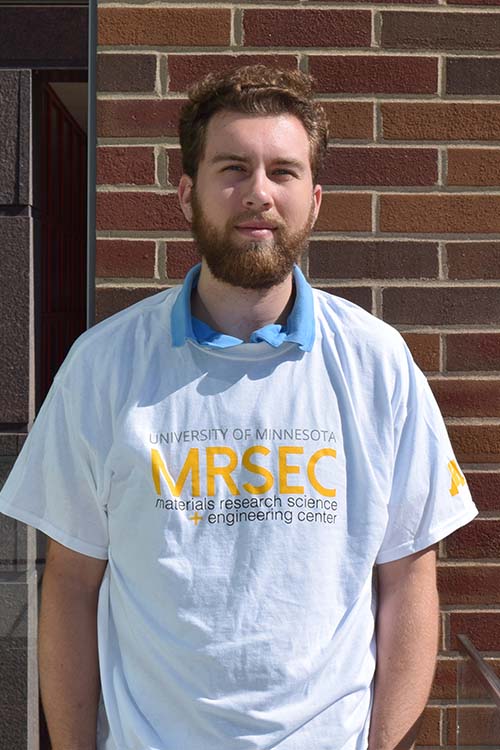
Home Institution: University of Delaware
REU Mentor: Theresa Reineke
A Renewably Sourced Pyrone for the Synthesis of Sustainable and Degradable Polymers
The ability to synthesize degradable polymers from renewable sources has become increasingly important due to the stress that current industrial polymeric materials impose on the environment.
Towards this synthetic end, various monomers have been synthesized from 5-hydroxy-3-methyl-2-pyrone, a renewably sourced unsaturated cyclic ester. Methacrylation of the pyrone and its reduced
lactone derivative has yielded monomers for use in radical-type polymerizations. Additionally, derivatives of the lactone are synthesized in order to generate linear polyesters via ring opening
polymerizations (ROP). Homopolymers from the mechacrylated pyrone were synthesized via uncontrolled, free radical polymerization and controlled, reversible addition-fragmentation chain transfer (RAFT)
polymerization; these polymers were subsequently characterized with size exclusion chromatography (SEC). Ring opening polymerizations (ROP) were attempted on ring strained lactones, and the
polymerizations were tracked via nuclear magnetic resonance (NMR) spectroscopy. The synthesized polymers represent progress towards creating sustainably sourced and degradable polymers with desirable
thermomechanical properties.
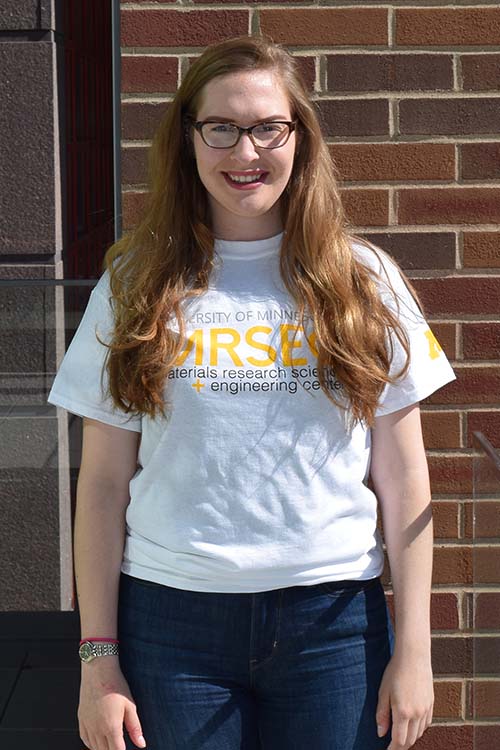
Home Institution: Princeton University
REU Mentor: Frank Bates
Methylcellulose Hydrogels: Templated Fibril Formation onto Cellulose Nanocrystals
The thermoreversible gelation of methylcellulose (MC) has been widely studied for decades and is commonly utilized in commercial food products, personal care products, and pharmaceuticals. MC undergoes a sol-gel transition above a critical temperature that depends on a variety of system parameters. The transition is driven by the assembly of the polymer chains into fibril structures
of a uniform diameter (~15 nm). Cellulose-based additives have recently been studied as a methodology to tune the storage modulus of MC. In this research, cellulose nanocrystals (CNC) were added
to MC solutions in relatively low concentrations (0.01-1%). Rheological characterization of MC-CNC solutions shows a trend of decreasing gelation temperature and maximum storage modulus as CNC
concentration is increased. The effect on the the structure of the MC system with the addition of CNCs was characterized before and after the sol-gel transition using small angle x-ray scattering (SAXS).
It was found that the CNCs did not changed the characteristic diameter of the MC fibrils. The interactions between the MC fibrils and CNCs were imaged using cryo-transmission electron
microscopy (cryo-TEM). A decrease in the average length of the MC fibrils was observed upon the addition of CNCs. The goal of future research will to observe the relationship between the CNCs and the nucleation of MC fibrils. The MC fibrils have exhibited some affinity to nucleating onto the CNCs. In the future, this could be applied to enhanced tunability of the MC system, allowing for the templating of the gel structure onto CNCs.
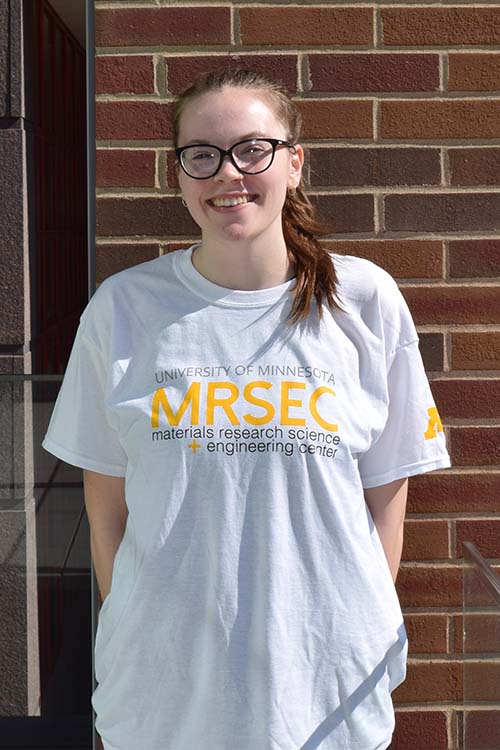
Home Institution: Hamilton College
REU Mentor: Vivian Ferry
Designing Efficient Quantum Dots for Luminescent Solar Concentrators
Luminescent solar concentrators (LSCs) use luminophores embedded in a polymer waveguide to concentrate direct and diffuse sunlight onto a solar cell. Concentration of solar radiation onto a solar cell
can improve efficiency and reduce cost. However, significant losses of incoming and emitted light can limit the ability of LSCs. In this work, we synthesized colloidal quantum dots to limit
reabsorption and increase quantum yield, two loss mechanisms related specifically to luminophore material itself. To reduce reabsorption, we synthesized core-shell quantum dots structures through
which the Stokes shift can be increased by altering the thickness of the shell. To increase quantum yield, we incorporated a high band gap semiconductor, ZnS, into core-shell heterostructures in order
to localize carriers in the core. Although a ZnS shell will promote localization, which can prevent trap states introduced by the environment, it will also increase the lattice mismatch, which can
introduce more trap states. Therefore, when ZnS is used alone as a shelling material, a reduction in quantum yield can occur. For this reason, we synthesized CdSe cores with CdS shells
(a material with a smaller lattice mismatch) before coating these shells with outer layers of ZnS and CdZnS. We found that although the CdSe/CdS quantum dots still had the highest quantum yield (70%),
the quantum yield of CdSe/CdS/CdZnS and CdSe/CdS/ZnS quantum dots could be increased to 64% and 53%, respectively, by increasing the number of CdS preliminary layers, synthesis times, and the ratio
of CdS to ZnS in alloyed layers.
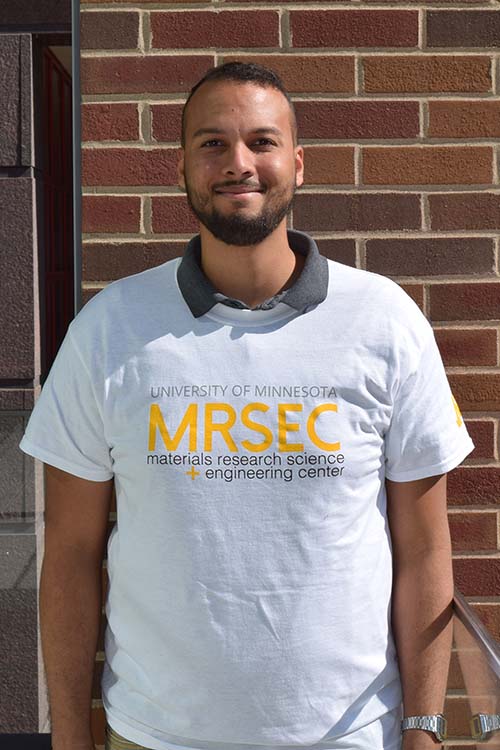
Home Institution: University of Puerto Rico Mayagüez Campus
REU Mentor: Xiaojia Wang
Optimization and Uniformity studies of Aluminum thin film deposition by magnetron sputtering on Si/SiO2 Wafers
Aluminum thin films commonly serve as metal transducers because of their large thermo-reflectance coefficient, good conductivity and their strong adhesion to the sample beneath. The magnetron
sputtering technology is suitable for large-area deposition of thin films with a relatively high deposition rate. The aim of this work is to study through electrical properties and thickness the
sputtering deposition uniformity of aluminum thin films on Si/SiO2 substrates. Improvement in the electrical conductivity measurements of the aluminum thin film will lead us to measure
better the thermal conductivity of future samples. Advancing the thermal properties understanding of composites materials and modern electronic devices.
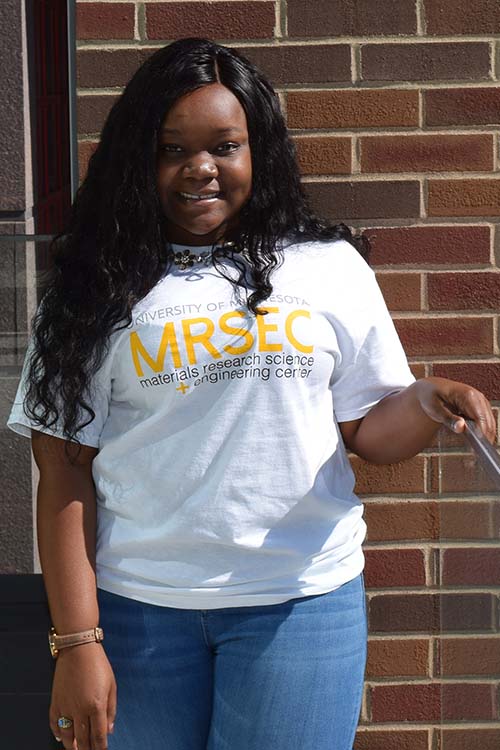
Home Institution: Alcorn State University
REU Mentor: Ben Hackel
Engineering Protein Expression
The molecular characterization of proteins has been widely studied to derive treatments for cancers and other diseases. In this experiment, the purpose is to improve the bacterial expression of
protein scaffold variants that bind to desired biomarkers relevant to the disease being studied. The scaffold protein of interest, Gp2, has two diversified regions yielding differences in expression
levels across variants. We propose to test the expression of the Gp2 variants in a high-throughput yeast secrete and capture assay as a proxy for bacterial expression. First, preliminary controls
will be completed to ensure the assay is functional: such as ensuring the conjugation of the capture antibody, the induction of conjugated yeast, and minimal cross-talk between cells.
The controls will conclude by using previously validated Gp2 variants to ensure that high bacterial expressing proteins will also perform well on the yeast secrete and capture assay.
Finally, a collection of one million variants will be screened to determine which characteristics of the diversified regions correlate to bacterial yield.
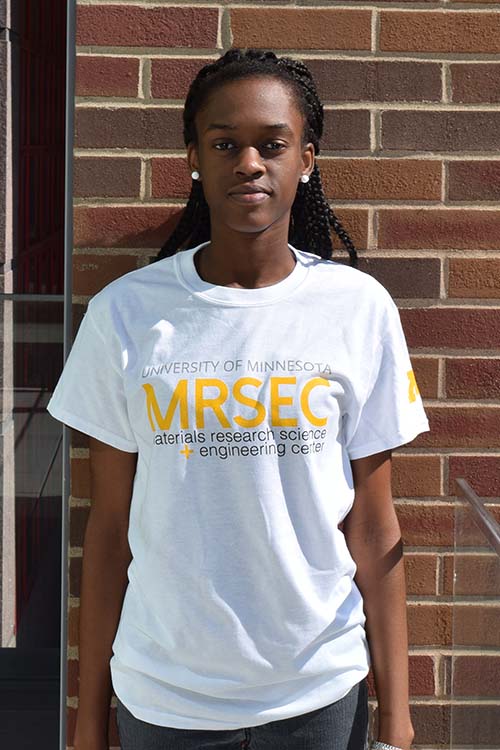
Home Institution: University of Florida
REU Mentor:
Lead-Free Perovskites for Optoelectronic Applications
Perovskite materials are used as light absorbers in solar panels. These materials are made up of an organo-metal-halide structure. Current perovskites solar cells have a power conversion
efficiency (PCE) of over 20%, however these perovskites contain lead which can be toxic for disposal. Several lead-free alternative perovskite materials have been proposed for use in solar panels
but have so far resulted in lower PCE devices. Methylammonium indium iodide (MA3In2I9) is one such lead-free alternative that has yet to be synthesized. We will
investigate the synthesis of MA3In2I9 in solid state and from solution by systematically studying the crystallization of this material. By varying experimental
parameters such as substrate identity, substrate washing procedure, reaction time and temperature, and ambient atmosphere we hope to identify the best procedures to develop large single crystals and
thin films for solar panel applications. X-ray diffraction, light microscopy, and UV-Vis spectroscopy will be used to characterize the products.
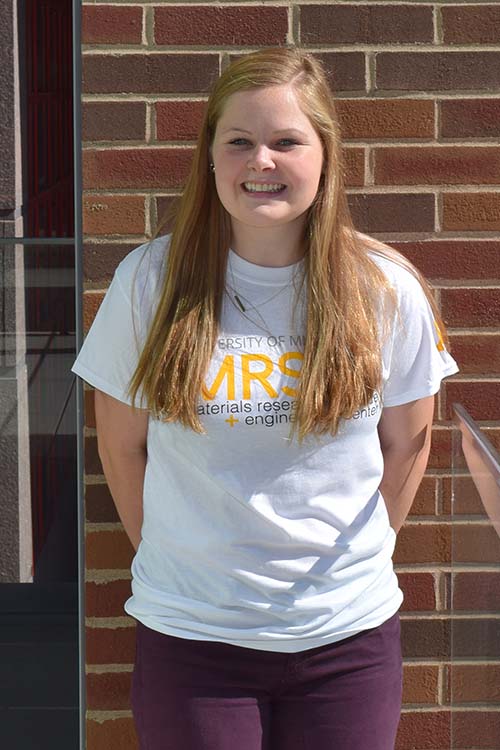
Home Institution: University of Illinois at Urbana-Champaign
REU Mentor: Theresa Reineke
Synthesis of Bottlebrush Polymers to Increase Solubility in Oral Drug Delivery
Oral drug delivery is an advantageous method for fighting disease, however it is currently limited by the low solubility of many drugs in the pharmaceutical pipeline. To counter this insolubility, bottlebrush polymers can be used as excipients in polymer amorphous solid dispersions (PASD) to increase solubility in the gastrointestinal tract. Bottlebrush polymers are composed of side chain polymers grafted to a backbone polymer, and we are using a bottlebrush with a poly(norbornene) backbone and co-polymer side chains of 70 weight percent N-isopropylacrylamide (NIPAm) and 30 weight percent N,N-dimethylacetamide (DMA). The composition of the side chains has already been optimized to minimize hydrophobicity and crystallinity (two factors affecting solubility) in the active pharmaceutical ingredient. Employing grafting-through techniques for our synthesis, we will use reversible addition-fragmentation chain transfer (RAFT) polymerization to synthesize macromonomers of poly(NIPAm-co-DMA) followed by ring opening metathesis polymerization (ROMP) of these macromonomers to form bottlebrush polymers. These techniques allow us to control the number of repeat units in the backbone of the bottlebrush polymer, the degree of polymerization of the side chains, and the grafting density of the side chains along the backbone. Through adjustments of each of these features on the bottlebrush, our goal is to make both the backbone and the side chains more hydrophilic to increase the overall solubility of the bottlebrush. From there, we will spray dry the bottlebrush with the model drug phenytoin and preform dissolution studies to analyze how different changes in the bottlebrush architecture effect the performance of the PASD.

Home Institution: University of California, Davis
REU Mentor: Paul Dauenhauer
Method Comparison for Chemisorption of Supported Platinum Catalysts
Measuring the size of platinum nanoparticles deposited on a support material is crucial to determine the turnover frequency for various catalytic reactions. Static and pulse titration are the two
adsorption methods to estimate the dispersion, surface area and crystallite size of these platinum particles. Transmission Electron Microscope (TEM) and X-Ray Diffraction (XRD) are other methods to
support these values. In order to quantify these adsorption methods, carbon monoxide was flowed through an alumina supported platinum catalyst with a known dispersion factor. The static method uses a
constant flow of carbon monoxide gas and is quantified by equilibrium pressure, whereas the pulse method streams a known amount of carbon monoxide and measures the uptake that did not adsorb onto the
catalyst. The static method is hypothesized to be more precise than the pulse method because the experimental time run is longer and measured not only the physisorption, but the combination on
chemisorption and physisorption for carbon monoxide.
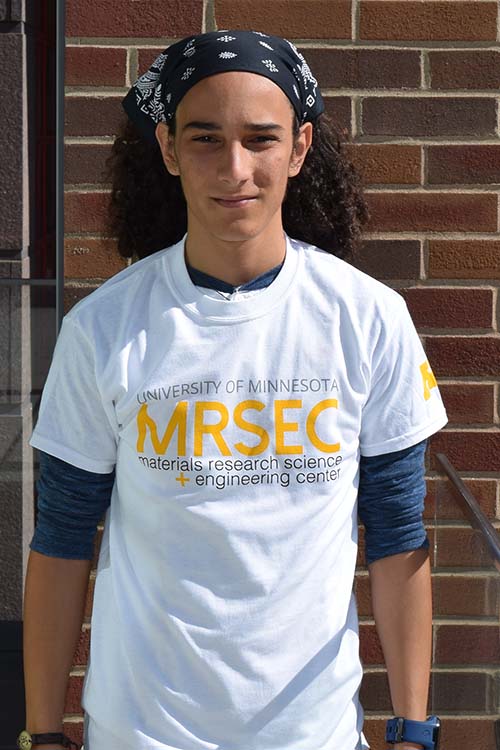
Home Institution: Universidad de Puerto Rico en Humacao
REU Mentor: Bharat Jalan
Alternative substrates for hybrid MBE grown BaSnO3 to achieve record-high electron mobilities
Complex oxides with perovskite structure display very interesting properties like superconductivity, magnetism, and metal-to-insulator transition behavior. Scientists have been studying these
materials in more detail and recently have drawn their attention to BaSnO3 as a potential transparent conductor because of its wide band gap and high electron mobility at room temperature.
Recent papers have reported mobilities up to 150 cm2 V-1 S-1 on PrScO3, a perovskite substrate, using hybrid molecular beam epitaxy approach. The hybrid MBE technique has produced
pristine BaSnO3 films and other complex oxides with nearly ideal surfaces, supported with structural characterization techniques. Although it has been demonstrated that MBE is an excellent
deposition technique, dislocation defects have also been reported. Imperfection of the film growth due to lattice mismatch between thin films and the substrates introduce dislocation defects
degrading the electronic properties of materials. We explored the possibility of using alternative substrates as an approach of increasing the critical thickness (hc), minimizing
dislocations throughout the films, and enhancing electronic properties on epitaxial films. Using Matthews-Blakeslee equation for critical thickness with MgAl2O4 Spinel (001) and
Gd3Ga5O12 Garnet (001), we have shown high theoretical critical thickness of BaSnO3 films grown on these substrates. Also, we report thermal stability of
substrates at typical MBE conditions by annealing samples in a furnace at 900°C under oxygen atmosphere.

Home Institution: University of Texas Rio Grande Valley
REU Mentor: Aakriti Kharel
Double Network Ion Gels
Ionic liquids serve as nonvolatile solvents that display high thermal stability and ionic conductivity. They have applications as actuators, separation membranes, polymer gel electrolytes, fuel cell
membranes, and ion battery components. Solidifying the ionic liquid, while maintaining transport properties, is essential for particular technological applications. This can be achieved through the
incorporation of a polymer network in ionic liquid through chemical or physical crosslinking. One of the ways to form a physically crosslinked network is by gelation of triblock copolymers in the
ionic liquid of interest that results in soft and flexible ion gel. On the other hand, a brittle ion gel can be formed through in situ polymerization of monomers in ionic liquids with a compatible
crosslinker that yields a chemically crosslinked network. We aim to incorporate both of these aforementioned networks; a heavily crosslinked, brittle, polymer network with high yield strength and a
highly elastic triblock copolymer network. The combination could potentially result in a double network ion gel with high toughness while retaining desirable ionic transport properties. Ionic liquid,
1-ethyl-3-methyl imidazolium bis(trifluoromethane sulfonyl)imide (EMI TFSI), will be used as a solvent for the double network. Methyl methacrylate will be polymerized through free radical
polymerization to create poly(methyl methacrylate) (PMMA) crosslinked with ethylene glycol dimethylacrylate (EGDMA), resulting in the chemically crosslinked network. The second network will
comprise of polystyrene-poly(ethyl acrylate)- polystyrene copolymer (SEAS).
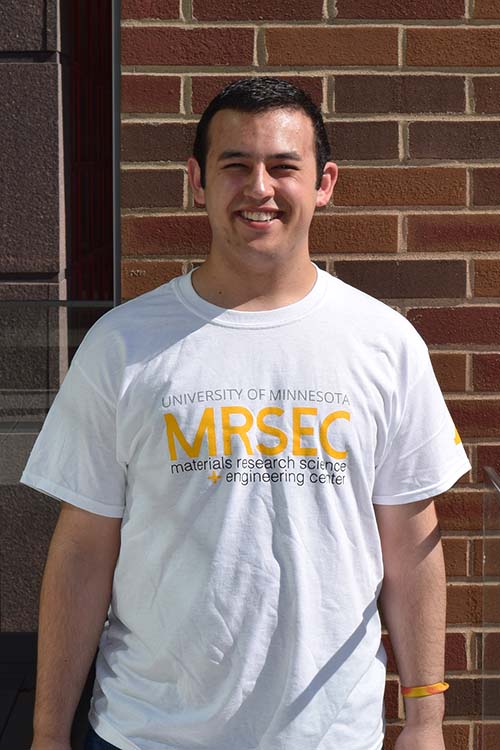
Home Institution: Creighton University
REU Mentor: Chris Hogan
Flame Synthesis of Lanthanum-Doped Barium Stannate (La:BaSnO3)
Perovskite oxides, cubic structured crystals of the formula ABO3, are a general area of research interest due their wide variety of potential applications, including semiconductor materials
and catalysts. Barium stannate (BaSnO3) has a perovskite oxide structure, and it exhibits interesting electronic characteristics, such as n-type conductivity and higher carrier
concentrations, when it is doped with lanthanum at the A-site. Lanthanum-doped barium stannate (La:BaSnO3) films are synthesized using a novel and scalable flame synthesis method.
Nanoparticles are created via pyrolysis in a flame from a precursor solution of 2-ethylhexanoic acid, tin (II) 2-ethylhexanoate, barium acetate, and lanthanum hydroxide. The synthesized products
are impacted onto alumina substrates at supersonic speeds to grow the films. The films are then annealed in a furnace at 1100 degrees Celsius. X-ray diffraction (XRD) is used to structurally
characterize the samples. Using XRD, it was found that all samples exhibited near identical structure to barium stannate, which indicates successful doping. However, scanning electron microscopy (SEM)
images show an abundance of cracks in the films, which inhibits their potential use as a semiconductor. Possible solutions to this problem, such as physical compression and a substrate coating of a
poly(methyl methacrylate) (PMMA) and acetone solution, are investigated.
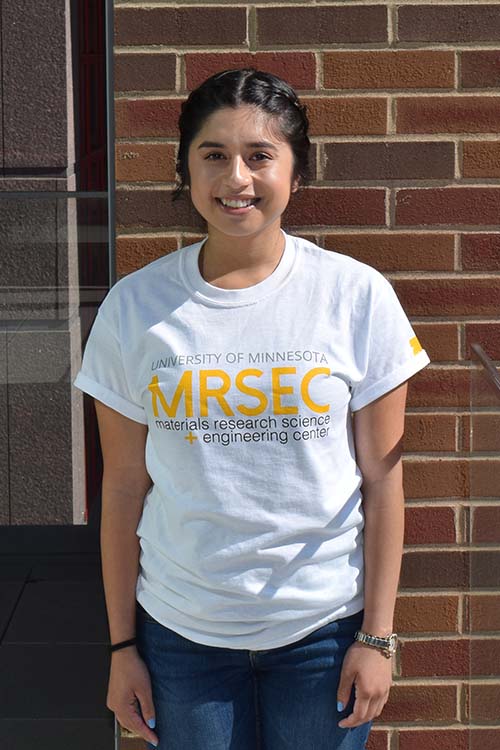
Home Institution: UC Berkeley
REU Mentor: Bharat Jalan and Richard James
Double Polymer Network Synthesis in Ionic Liquids for Increased Ion Gel Toughness
Waste heat in small magnitudes is being discarded; however, over time, a significant amount of energy could be used more efficiently if this waste heat is minimized. To approach this problem, we use Barium Titanate, BaTiO3, which has been of interest to scientist since the 1940’s due to its unique phase transition. It is known that when BaTiO3 is heated up to its Curie temperature (120°C), it transitions from a tetragonal (ferroelectric) phase to a cubic (paraelectric) phase. During this transition, there is a release in heat which we want to convert to a more effective source of energy. We are putting together an energy converting demonstration where test probes are connected to BaTiO3 as its temperature increases to 120°C. Since BaTiO3 is not conductive, we layer it between two sheets of Platinum which allow an electrical current to run from the sample through a closed circuit allowing us to find a voltage as temperature varies using a multimeter. Data is then collected from the multimeter using a Labview program which allows us to analyze the relationship between temperature and voltage produced. If we find a peak in voltage at the Curie temperature after numerous iterations using this method, we will be able to confirm that this energy converting demo works. This system can then be applied to many electronic systems that have small waste heat allowing energy to be used more efficiently.

Home Institution: Columbia University
REU Mentor: Xiang Cheng
Chemical Propulsion Methods of Platinum Janus Particles
Nano-scale colloidal particles become Janus particles when their surface is chemically asymmetric. The varied composition of Janus particles gives them interesting properties whose applications
include microprobes, micromotors, electronic paper, and solid surfactants. Using metal evaporation, polystyrene and silica colloids have one hemisphere coated with platinum to form Janus particles.
Upon being released into a solution of hydrogen peroxide, chemical propulsion of the particles is produced. By varying the sizes of monomer and dimer Janus particles, the mechanisms of chemical
propulsion may be better understood.
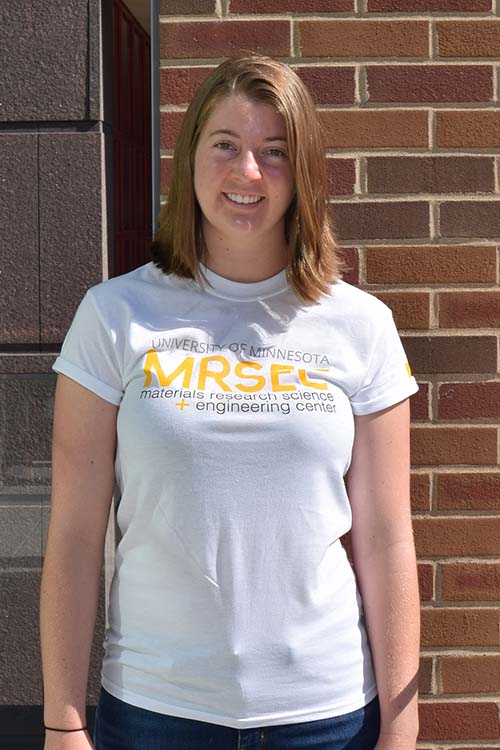
Home Institution: New Mexico State University
REU Mentor: Mahesh Mahanthappa
End Group Effects on Aqueous Self Assembly of Diblock Copolymers
Amphiphilic molecules self-assemble in selective solvents such as water to yield a plethora of morphologies including discrete micelles packed on a lattice (I), hexagonally packed cylindrical
micelles (H), bicontinuous networks (N), and lamella (L). The self-assembly is driven by the need to decrease unfavorable contacts between the hydrophobic and aqueous domains. During the summer of
2017 an REU student in our group discovered that aqueous dispersions of polyethylene-b-polyethylene oxide (PE-PEO) polymer form various discrete micellar morphologies including a Frank-Kasper σ phase
which consists of 30 micelles of 5 different types in a tetragonal unit cell. This was the first report of the formation of the intermetallic σ phase in solutions of diblock polymers.
We speculate that self-assembly of the polymer can be manipulated by varying the end groups of the polymer. We will replace the hydrophilic –OH end group with a less polar –OCH3 group,
and an ionic –SO3Na group and thoroughly investigate its effects on the polymer phase behavior in water. We will map the concentration- and temperature-dependent phase diagram using
differential scanning calorimetry (DSC), and small-angle X-ray scattering (SAXS). Correlating the phase behavior with the end-groups will furnish insights into controlling self-assembly of
aqueous diblock polymer solutions via minute molecular modifications.
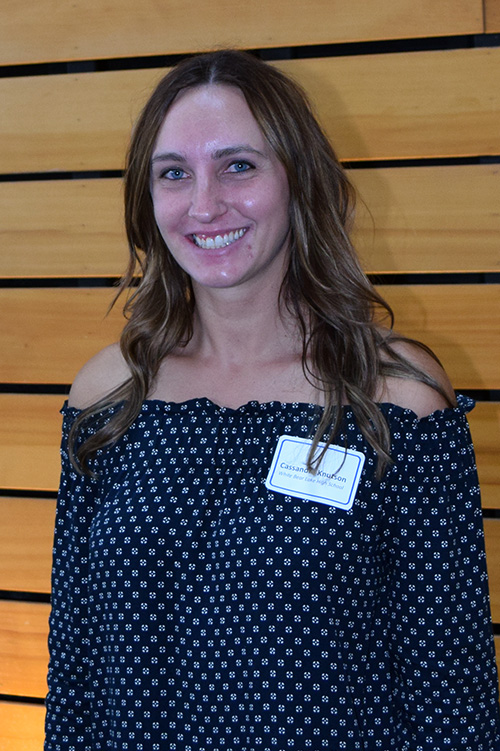
School: White Bear Lake High School
Mentor: Jane Wissinger
Teaching Green: Engaging High School Chemistry Teachers in Sustainability
If tomorrow’s chemists are today’s students, then it is essential that they are given the tools and knowledge needed to create healthy and safe products and processes for humans and the environment. In an effort to share resources that empower educators and students to practice sustainability through green chemistry, we delivered a three day workshop to twenty high school chemistry teachers from Minnesota for the second consecutive summer. The workshop participants received instruction and resources on the pillars of sustainability and the principles of green chemistry while gaining hands-on experience with safer cost-effective labs that are drop-in replacements for traditional high school chemistry labs. In addition, participants explored two polymer-based experiments that focus on plastics and their connections to sustainability and relevance to society. Several modifications were made to this summer’s workshop in response to the participant survey feedback received last summer. Survey feedback from this summer’s workshop participants was extremely positive, and it was evident that the changes made were successful. Following the workshop, an experiment that explores the synthesis of bioplastics and the rates of their degradation was refined for publication for a high school audience to address the need for green chemistry curricula that align with standards and support inquiry-based learning.
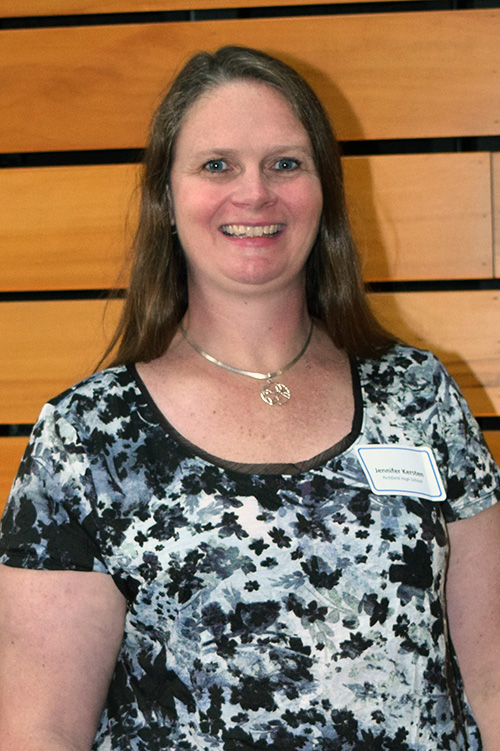
School: Richfield High School
Mentor: Dan Frisbie
Capillary-Assisted Printing of Conductors and Resistors
The subject of electricity and basic circuits is a fundamental component of most high school physics courses. The electronics industry is constantly evolving, which provides the opportunity to make the content of a high-school-level physics course up-to-date and relevant. Printed electronics give students a glimpse into cutting-edge circuitry with a myriad of potential uses. By utilizing capillary flow to create these electronics, cost and complexity of manufacture would be kept to minimum. Research was done producing both conductors and resistors on flexible substrates. In the lab, work was done with both hand and inkjet printing, although it is anticipated that the use of hand printing is most reasonable for high school students in the classroom. Success was obtained in the production of conductors that were used in the lighting of mini holiday lights and resistors that were used in lighting LED bulbs, both components produced with a range of resistance values. After research in the printed electronics area, it is expected that printed circuits could be introduced into a physics curriculum to strengthen the connection between learning of basic circuits, with conductors and resistors, and current scientific research.
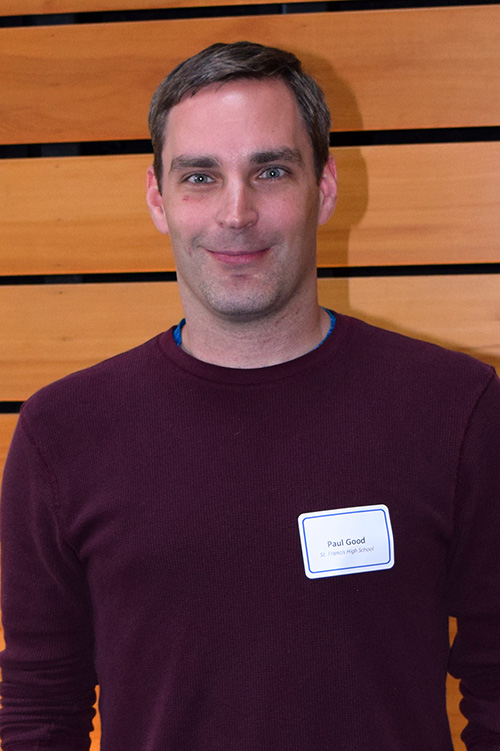
School: Richfield High School
Mentor: Dan Frisbie
Capillary-Assisted Printing of Conductors and Resistors
The subject of electricity and basic circuits is a fundamental component of most high school physics courses. The electronics industry is constantly evolving, which provides the opportunity to make the content of a high-school-level physics course up-to-date and relevant. Printed electronics give students a glimpse into cutting-edge circuitry with a myriad of potential uses. By utilizing capillary flow to create these electronics, cost and complexity of manufacture would be kept to minimum. Research was done producing both conductors and resistors on flexible substrates. In the lab, work was done with both hand and inkjet printing, although it is anticipated that the use of hand printing is most reasonable for high school students in the classroom. Success was obtained in the production of conductors that were used in the lighting of mini holiday lights and resistors that were used in lighting LED bulbs, both components produced with a range of resistance values. After research in the printed electronics area, it is expected that printed circuits could be introduced into a physics curriculum to strengthen the connection between learning of basic circuits, with conductors and resistors, and current scientific research.

School: Cherry Creek High School
Mentor: Christy Haynes
Microfluidic Device Design for High School Implementation Using Shrinky-Dinks®, PDMS, and Cricut Maker
Microfluidics is the study of the behaviors of fluid through micro-channels. Microfluidic devices utilize small volumes of fluids that flow through a device with channels of the micrometer scale
designed to achieve specific results. There is a need to teach new innovative science practices related to microfluidics and challenge student to engage in engineering practices correlated with
science. This experiment utilizes previous accepted ways to construct microfluidic devices using polydimethylsiloxane (PDMS) and redesigns these practices to provide high school teachers the
ability to construct reliable, repeatable, reproducible, and cost effective microfluidic devices. This key finding in this experiment was that using a Cricut Maker to design and cut out channels
in Shrinky-Dinks® film provided a higher success rate that could be implemented best in a high school classroom. Microfluidic devices can be used for a multitude of purposes and offers
students opportunities to develop engineering skills, reduce chemical volumes in teaching labs, and explore a variety of chemistry topics, such as acid-base chemistry.
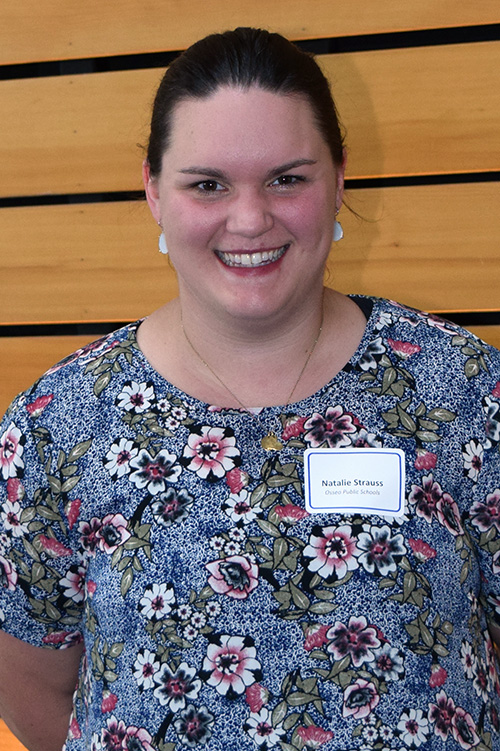
School: Osseo Public Schools
Mentor: Ben Hackel
Using Enzymes for Teaching Kinetics in High School Chemistry
Kinetics is an engaging topic in the Minnesota High School Chemistry curriculum with many opportunities for lab work and demonstrations. It is sometimes difficult for students to see how the labs and demonstrations about kinetics might relate to their everyday lives. This lab work builds on work about enzyme specificity for a higher level chemistry class to look at how enzymes can be used to teach about kinetics in a general level high school chemistry classroom. Students use basic household materials and colorimetry to study how enzymes degrade substrates under varying conditions and relate this learning to real life enzymatic activity in the body and in products such as laundry detergent.
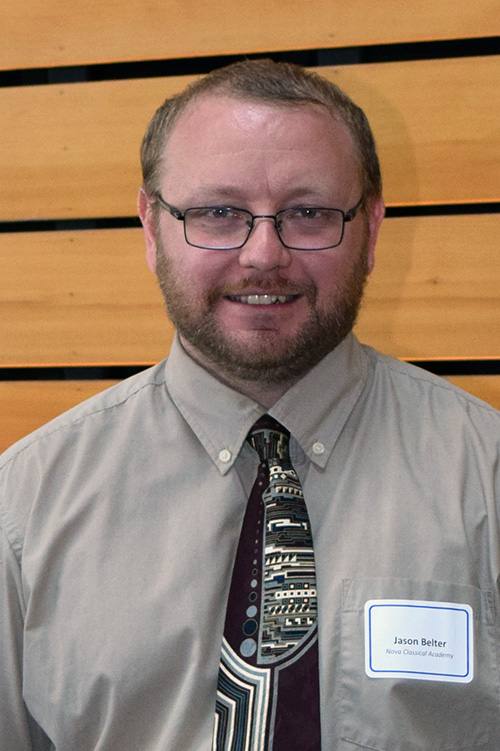
School: Nova Classical Academy
Mentor: Jane Wissinger
Green Chemistry in PLAin sight
Polylactic Acid (PLA) is a biodegradable, inexpensive, and readily available polymer. In collaboration with Boston College a lab activity was developed to highlight one possible use for this polymer: cleaning up oil spills. The experiment involves making thin films of PLA with different characteristics, immersing them in a simulated oil spill and measuring their ability to adsorb dodecane (our simulated oil). This work sought to investigate a number of different sources of PLA to provide extensions and modifications to the standard protocol and allow teachers to more easily customize the experiment to meet their curricular needs. Shelf stability of the PLA/solvent mixture was also tested, and methods for more precisely measuring small volumes of the viscous polymer were explored. The experiment highlights a number of principles of Green Chemistry and sustainability while also giving students hands on experience with polymer chemistry. Further topics such as plastics in our society and their effect on human health and the environment engage students in real-world problems to be solved.
UMN MRSEC
435 Amundson Hall, 421 Washington Ave. SE, Minneapolis, MN, 55455
P: 612-626-0713 | F: 612-626-7805